Bronco Sport fills popular Ford SUV niche
By John Gilbert
Vehicle buyers are nothing if not eager to jump onto whatever trendy bandwagon might be coming around the block. And manufacturers are quick and clever about heading off our desires with products we just can’t do without.
A perfect case in point is the new Ford Bronco, which is a compact SUV adorned with the beloved name out of the past, when Ford made a Bronco that was big and square and rugged and primitive, but would haul stuff and operate as a family utility vehicle before the term SUV had been dreamt up. Its ruggedness worked for adventurers who rambled off the beaten paths. It had two rows of seats and the rest was for stowage. It was not designed for comfort so much as for taking folks into the hinterlands, beyond roads.
In the years since the original Bronco bucked its way into history, Ford has fought the good fight about designing and building SUVs from the tiniest subcompact on up through the largest Expedition, with a half-dozen or more steps in between those extremes.
But as sophistication settles in, Ford has found a way to wedge an all-new compact SUV in among the Explorers, Escapes, Edges, Expeditions and all, and it did it right — even including revisiting the name Bronco. The new Bronco is a squarish but attractive body plunked down on the impressive drivetrain of the compact Escape, including the 2.0-liter EcoBoost 4-cylinder engine and 8-speed transmission.
An interesting wrinkle is that there are two Broncos — a normal Bronco and a Bronco Sport. The Bronco Sport is actually a bit smaller than the Bronco proper, and it shares unibody construction with the Escape. I have not yet driven the Bronco, but I have had some extensive test-drive time with the Bronco Sport, in fact it was the Bronco Sport Badlands edition, and along with more compact size, it comes with revised suspension, all-wheel drive, and rear cargo floor that is covered with a rubberized material that goes up the rear seat backrests.
The rear seats fold forward and create a long flat floor for hauling bulky things, although I didn’t try it out to see if I could curl up back there for a nap.The floor can be used as a small picnic table, and if you and your family get messy, you can hose off the rear area without risking damage.
I was able to take the Bronco Sport Badlands on a drive from Duluth to eastern St. Paul, and it was during a weird heat spell. That was the first time I have actually seen the instrument panel temperature gauge on any test vehicle register an honest 100 degrees. I even took a picture of it, because it was so unusual.
Inside, of course, there was no direct knowledge of how hot it was outside because of the excellent air-conditioning system that kept us comfortably chilled and able to do the 400 miles of down and back driving.
I have always liked the newest model of the Escape for its bold design and decent performance, but it surprises me to note that the Bronco Sport Badlands felt quicker, and cornered and handled more adroitly than the Escape. Maybe it was the revised suspension, but it also worked on the freeway, holding pace with ease and delivering 26 miles per gallon at steady speed
The Bronco Sport came in Rapid Red metallic, with some unique ebony cloth seats that held you firmly in place. The dashboard, too, is covered with padding.
Its base price rose from $32,660 to $36,140 by adding the CO-Pilot360 assist for surround viewing when backing up or parking, and 17-inch low-gloss aluminum wheels.
Ford also offers a turbo 3-cylinder in the Bronco Sport, but the 2.0 worked just fine for me, and had good acceleration and coordinated well with the 8-speed automatic transmission, which could be manually controlled with paddle shifters on the steering wheel.
There also is a mode switch that is nothing if not thorough for virtually any driving situation you can find. Set it on normal, or switch one way to go to Eco, Sport, or Slippery; go the other way and you can get Mud and Ruts, Sand, or Rock Crawl — for those who want to take it way out off road.
Outside, the square corners are rounded off stylishly, and LED headlights and taillights announce you are arriving brightly. Or at least your Bronco Sport is.
You may enter a Ford dealership thinking of comparing a Bronco and the Bronco Sport, but my suggestion would be more to compare the sleek, low and sporty Escape, or the squarish but attractive Bronco Sport with the same drivetrain. Don’t assume the sportier Escape will handle better, though. You need to drive them both to see if you agree with me that the Bronco Sport is ready for the freeway, or the Badlands.


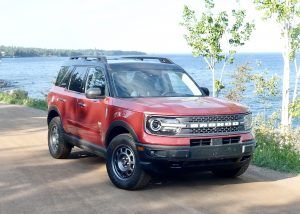
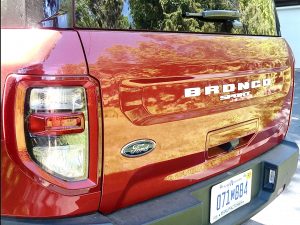
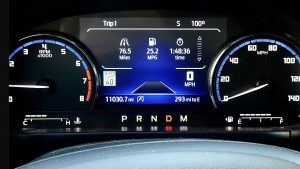
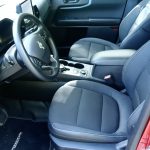
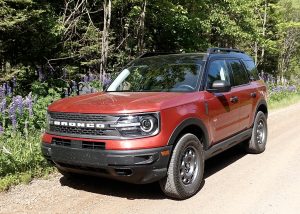
 John Gilbert is a lifetime Minnesotan and career journalist, specializing in cars and sports during and since spending 30 years at the Minneapolis Tribune, now the Star Tribune. More recently, he has continued translating the high-tech world of autos and sharing his passionate insights as a freelance writer/photographer/broadcaster. A member of the prestigious North American Car and Truck of the Year jury since 1993. John can be heard Monday-Friday from 9-11am on 610 KDAL(www.kdal610.com) on the "John Gilbert Show," and writes a column in the Duluth Reader.
John Gilbert is a lifetime Minnesotan and career journalist, specializing in cars and sports during and since spending 30 years at the Minneapolis Tribune, now the Star Tribune. More recently, he has continued translating the high-tech world of autos and sharing his passionate insights as a freelance writer/photographer/broadcaster. A member of the prestigious North American Car and Truck of the Year jury since 1993. John can be heard Monday-Friday from 9-11am on 610 KDAL(www.kdal610.com) on the "John Gilbert Show," and writes a column in the Duluth Reader.